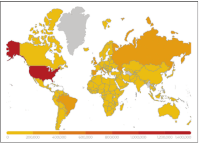The Coronavirus Pandemic: Why the Continent of Africa Appears Relatively Spared in Severity – An Immunological Perspective
Main Article Content
Abstract
Introduction
The World Health Organization has rightly coded coronavirus disease as COVID‑19 as it started in December 2019 in the city of Wuhan, in Hubei province of China. Coronaviruses are a family of viruses which have always been in existence for millennia and were
known to infect mainly animals. Due to the weird social and occupational habits of man, these viruses now have cross infectivity in humans, either intentionally or by accident on the part of man. In the past 20 years, there have been two noted outbreaks of coronaviruses, though of relatively less severity and spread, namely, severe acute respiratory syndrome (SARS) and Middle East respiratory syndrome (MERS).[1] SARS and MERS were effectively curtailed, but the COVID‑19 is posing a horrendous threat to humankind by virtue of its casualties already experienced, and the casualties appear to mount by the hour in relatively advanced nations and temperate regions of the world. As at this moment, about 4 months into the pandemic, the African continent has 23,207 cases, with 1131 deaths; Europe has 1,011,640 cases with 103, 663 deaths; North America has 824,147 cases with 43,564 deaths; Asia
has 389,832 cases with 14,942 deaths; South America has 83,219 cases with 3880 deaths; and Oceania has 8157 cases with 83 deaths.[2]
Downloads
Article Details
Section

This work is licensed under a Creative Commons Attribution-NonCommercial-ShareAlike 4.0 International License.
How to Cite
References
Yin Y, Wunderink RG. MERS, SARS and other coronaviruses as causes of pneumonia. Respirology 2018;23:130‑7.
World Health Organization. Coronavirus Disease (COVID‑19) Dashboard. World Health Organization; 2020. Available from: https://
covid19.who.int/. [Last accessed on 2020 Apr 20].
Phillips H, Killingray D. The Spanish Influenza Pandemic of 1918‑1919: New Perspectives. London: Routledge (Routledge Studies in the Social
History of Medicine); 2003. Available from: https://biblioteca.sagrado.edu/eds/detail?db=nlebk&an=97571. [Last accessed on 2020 May 19].
Johns Hopkins University. Coronavirus Resource Centre. Available from: https://coronavirus.jhu.edu/map.html 2020. [Last accessed on
May 18].
Firquet S, Beaujard S, Lobert PE, Sané F, Caloone D, Izard D, et al. Survival of enveloped and non‑enveloped viruses on inanimate surfaces.
Microbes Environ 2015;30:140‑4.
Voets PJ. On the antigen‑antibody interaction: A thermodynamic consideration. Hum Antibodies 2017;26:39‑41.
Savarino A, Boelaert JR, Cassone A, Majori G, Cauda R. Effects of chloroquine on viral infections: An old drug against today’s diseases.
Lancet 2003;3:722‑7.
Srinivasan V, Spence DW, Trakht I, Pandi‑Perumal SR, Cardinali DP, Maestroni GJ. Immunomodulation by melatonin: Its significance
for seasonally occurring diseases. Neuroimmunomodulation 2008;15:93‑101.
Jappe EC, Kringelum J, Trolle T, Nielsen M. Predicted MHC peptide binding promiscuity explains MHC class I ‘hotspots’ of antigen presentation defined by mass spectrometry eluted ligand data. Immunology 2018;154:407‑17.
Lytle CD, Sagripanti JL. Predicted inactivation of viruses of relevance to biodefense by solar radiation. J Virol 2005;79:14244‑52.






